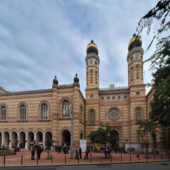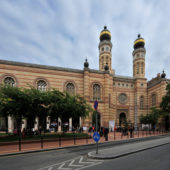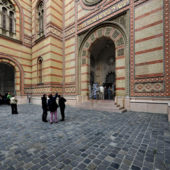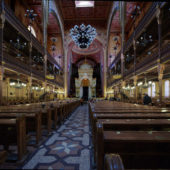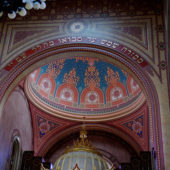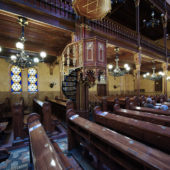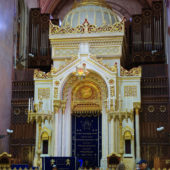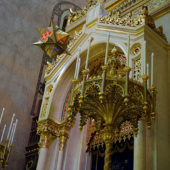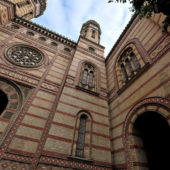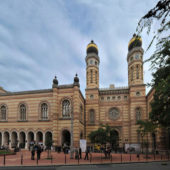The second largest synagogue in the world and largest in Europe.
The impressive Dohany Street Synagogue (otherwise known as The Great Synagogue) is not only the largest synagogue in Europe, but the second largest in the world. Nearly 150 years old, this spectacular Synagogue was consecrated on September 6, 1859. Its design is Oriental-Byzantine (Moorish), influenced by Moslem architecture. The Synagogue can accommodate 2,964 people sitting, with an additional 2,000 people standing. In addition to being a Jewish house of worship, major cultural events for the city are hosted in the Great Synagogue. The Hungarian Jewish Museum is inside the Synagogue building. Dohany Street itself, where the Synagogue is located, is the border of what used to be the Budapest Ghetto.
This magnificent Synagogue was designed by Viennese architect, Christian Friedrich Ludwig Foerster. Based on the Moorish Revival style, its architectural influences primarily came from Islamic examples in North Africa and Medieval Spain (the Alhambra). Foerster believed that there was no “Jewish” architectural style; therefore, he chose, “architectural forms that have been used by oriental ethnic groups that are related to the Israelite people, and in particular the Arabs.”[1] Romantic and Gothic elements are also seen. Built between 1854 and 1859, the section of the Synagogue with the twin towers is the oldest. A large rose stained glass window sits over the main entrance. Two colors of brick create horizontal striping in the building, and Moorish motifs are repeatedly used with fine detail and moldings to beautiful effect. Due to the strong Moorish influence and Onion shaped domes on top of the twin towers, the Synagogue has frequently been mistaken for a mosque. Above the main entrance gate, the following inscription is inscribed in Hebrew, “And let them make Me a sanctuary so that I may dwell among them.” (Ex. 25:8).
Inside the spectacular prayer-room, it is not unlike a basilica. The sanctuary is separated into three spacious, sumptuously decorated aisles, with the Aron-Kodesh at the front with the organ hidden behind it, and the women’s galleries running upstairs for two stories, along both sides and the back of the sanctuary. The ceiling and dome are intricately decorated, supported by arches with beautiful sweeping lines, all of which are painted with exquisite detail. Over one arch there is a Hebraic inscription. Arched, stained glass windows adorn the side-walls, and a huge chandelier drops down in the front of the sanctuary. Smaller chandeliers light the sides and back of the prayer-room. The statuesque Aron-Kodesh is imposing in white with its dome on top, intricately molded and gilded. A black Torah curtain with gold Hebrew lettering is drawn across the front. Inside the Aron-Kodesh are Torah scrolls obtained from other synagogues destroyed during the Holocaust. There is a dome in the ceiling above the Aron-Kodesh, which is also intricately decorated. The famous Hungarian romantic architect Frigyes Feszi created the magnificent Torah-Ark and internal frescoes of colored and golden geometric shapes. Two tall, finely detailed, gold menorahs with white candles stand on the platform on either side of the Aron-Kodesh. There are two tivahs (reader’s desks), on either side of the sanctuary, designed in the style of many churches, featuring circular stairs, a platform with carved wood and gilded balustrade with canopy above. The 5,000 pipe organ, which is hidden behind the Aron-Kodesh, was built in 1859. A new mechanical organ, with 63 voices and 4 manuals, built in 1996 by the German firm Jehmlich Orgelbau Dresden GmbH, was also acquired. The floors are intricately tiled mosaics.
Although the women’s gallery is two-stories, the 2nd and 3rd floors upstairs, running along the sides and back of the sanctuary, today women are allowed to sit with the men in the pews in the main sanctuary. The beautiful wood-paneled galleries highlighted with gilding are supported by slim columns, which are also intricately carved and highlighted with gilding, rising through both stories of galleries to the ceiling.
Next door to the Synagogue was a two-story house where Theodor Herzl, the founder of Zionism, was born and raised. In 1930-1931 the Jewish Museum was built on the foundations of what used to be Herzl’s home and this was built adjoining the Synagogue. There is a square in front of the museum, bearing Herzl’s name. The museum boasts a bountiful collection of religious artifacts of the Pest Hevrah Kaddishah, ritual Sabbath and High Holiday objects, a Holocaust room, a historical room, as well as a room for housing temporary exhibitions and organ concerts. Franz Liszt has played the organ concerts there and today, Xaver Varnus performs there.
The original Synagogue was bombed by the pro-Nazi Arrow Cross Party on February 3, 1939. During WWII it was used as a base for German Radio and as a stable. It suffered severe damage from aerial raids during this time, and during the Siege of Budapest, in particular. The Synagogue underwent restoration in the late ‘90s, which was financed by State and private donations, and in particular, by Hungarian Jewish immigrant Estée Lauder who made her fortune in the cosmetics industry.
Dohany Synagogue remains home to a vibrant congregation, today. It has daily services, Shabbat and High Holidays services. The Synagogue also offers tours of the Synagogue to tourists and the museum is open for visitors.
[1] Ludwig Forster, Allgemeine Bauzeitung, 1859, pp. 14-16.

